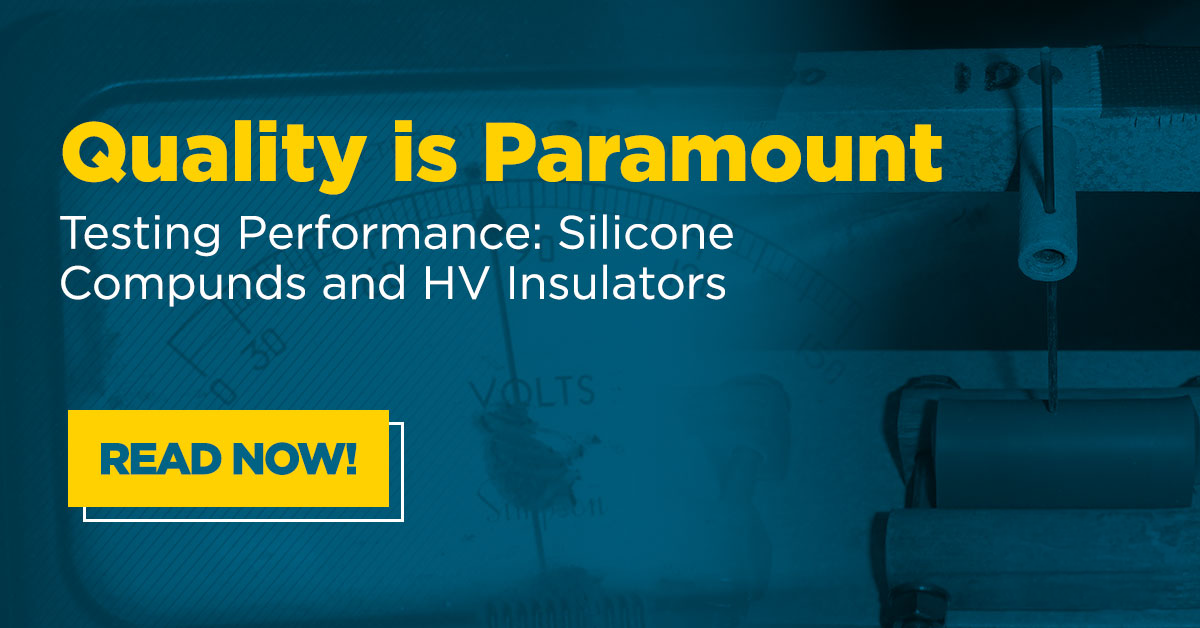We talked previously about the science behind compounding superior silicone rubber for polymer insulators. What’s next? Today, let’s look at the stringent testing these polymer compounds undergo once they are mixed with the other ingredients. They must perform well before they can be utilized in an assembled high voltage insulator.
A lot is at stake
The particular silicone rubber compound used in your insulators must be right on the money. After all, a lot is at stake. Cost is important, long life is important, reliability is important, electrical performance is important--and safety is paramount. But how do you know your high-voltage insulators belong in the winner’s circle and on your utility poles?
It’s simple. For peace of mind that you made the right choice, take a closer look at how a silicone compound performs on five important tests. You can also read more about it in our white paper.
Hydrophobicity
Hydrophobicity is the property that prevents water from forming a sheet on the surface of a polymer. As hydrophobicity increases, leakage currents decrease.
It is typically measured in one of two ways:
- In the lab, a contact angle measurement is performed. This sensitive test measures the angle between a water drop and the sample surface. To be considered hydrophobic, the contact angle must be at least 90 degrees; superhydrophobic is when the contact angle is greater than 150 degrees.
- In the field, or when the sampling is large, the STRI (Swedish Transmission Institute) method is used.
Tracking and erosion-resistance
Early in the 1900s, ways of testing glazes on porcelain insulators were developed. Originally, the industry referred to these as erosion tests but today they are called tracking and erosion resistance tests. Having well-established testing procedures developed for ceramic on hand was instrumental for developing advanced silicone rubber compounds.
Tracking and erosion testing specifically measures the response of silicone rubber through four stages of degradation:
- Loss of hydrophobocity
- Dry band arcing
- Formation of silica layer
- Erosion
Ultraviolet
Polymer insulating compounds are exposed to ultraviolet radiation from three sources: sunlight, corona, and dry band arcing. The exposed polymers absorb UV radiation—which may lead to mechanical and chemical degradation.
Under accelerated testing methods, such as ASTM G53 (QUV), a good polymer compound should be capable of sustaining 10,000 hours of exposure without crazing, cracking, or displaying any loss of hydrophobocity.
Corona
Corona discharges form at the surface of an insulator when the electric field gradients on the surface exceed the dielectric strength of air. Corona accelerates the aging of polymers by generating ozone and ultraviolet light. Additionally, the electric discharge subjects the insulator to severe electrical strain and chemical degradation. Electrical insulation which may be subjected to corona must be made from a properly compounded silicone rubber.
Polymer insulator samples are subjected to a mechanical stress of approximately 300,000 microstrain by bending the sample over a grounded electrode. Under a combination of mechanical strain and continuous surface corona, an unaged polymer should be capable of surviving at least 1,000 hours without cracking, splitting, cutting, or flashing over.
Oxidative stability
Antioxidants are incorporated into a polymer compound to inhibit the attack of oxygen and ozone on the compound’s chemical composition. An oxidative stability test measures the time required to deplete the antioxidants within a material under controlled conditions. Oxidation stability is measured by using the thermal analysis technique of differential scanning calorimetry (DSC)—which measures the amount of heat flowing into or out of the sample as a function of sample temperature.
Conclusion
Not all silicone compounds are equal. Today, Hubbell’s proprietary hydrophobic silicone rubber insulators provide advanced options for customer applications. Additionally, we offer a proprietary polymer silicone blend—known as ESP.
Our polymer insulators meet or exceed all appropriate regulations/requirements for their use around the world. Using the five tests summarized above, you can be confident that Hubbell high-voltage polymer insulators provide high performance, long life, and peace of mind.
Find out more about how our ESP polymer and silicone rubber compound perform in our white paper: "Silicone Compounds for High-Voltage Insulators: HPS Testing of Silicone Compounds".
To learn more about polymer insulators, check out our entire educational blog series. We’re here to help. To talk to someone, please reach out to your Hubbell sales rep.



